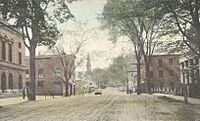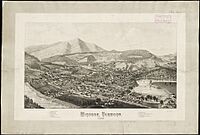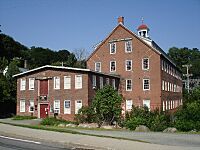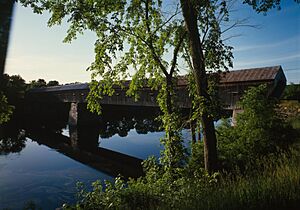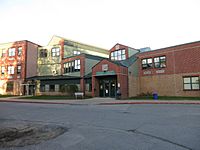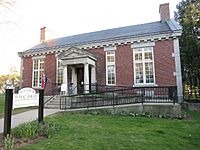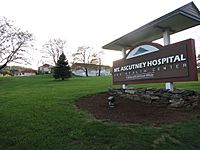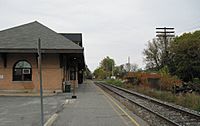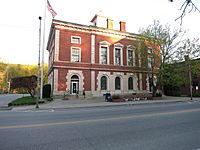Windsor, Vermont facts for kids
Quick facts for kids
Windsor, Vermont
|
|
|---|---|
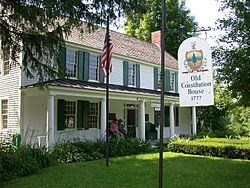
Old Constitution House, where the Constitution of the Vermont Republic was signed
|
|
| Motto(s):
Birthplace of Vermont
Freedom and Unity |
|
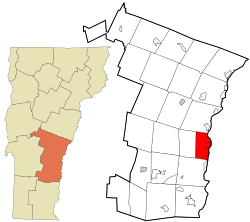
Location in Windsor County and the state of Vermont.
|
|
| Country | |
| State | |
| County | Windsor |
| Communities | |
| Area | |
| • Total | 19.8 sq mi (51.2 km2) |
| • Land | 19.5 sq mi (50.6 km2) |
| • Water | 0.2 sq mi (0.6 km2) |
| Elevation | 1,066 ft (325 m) |
| Population
(2020)
|
|
| • Total | 3,559 |
| • Density | 179.7/sq mi (69.51/km2) |
| Time zone | UTC-5 (Eastern (EST)) |
| • Summer (DST) | UTC-4 (EDT) |
| ZIP Codes |
05089 (Windsor)
05037 (Brownsville) |
| Area code(s) | 802 |
| FIPS code | 50-84925 |
| GNIS feature ID | 1462266 |
Windsor is a town in Windsor County, Vermont, United States. It's known as the "Birthplace of Vermont." This is because the Constitution of Vermont was signed here in 1777. This event created the Vermont Republic, which was like its own country until 1791. Then, Vermont joined the United States. For a long time, Windsor was a busy place for making things in factories. In 2020, about 3,559 people lived in Windsor.
Contents
History of Windsor
Early Settlement and Founding
Windsor was officially started as a town on July 6, 1761. This happened when the colonial governor, Benning Wentworth, gave it a special paper called a charter. The first people to settle here arrived in August 1764. They were Captain Steele Smith and his family. They came from Farmington, Connecticut. The town was named after Windsor, Connecticut.
Birthplace of Vermont
In 1777, something very important happened in Windsor. People met at the Old Constitution House, which was a tavern back then. They signed the Constitution of the Vermont Republic. This document declared Vermont's independence from Great Britain. Vermont became its own independent state, called the Vermont Republic. It wasn't until 1791 that Vermont joined the United States.
Windsor was the first capital of Vermont. It stayed the capital until 1805. Then, Montpelier became the official state capital.
Growth and Industry
By 1820, Windsor was the biggest town in Vermont. It was a busy place for trade and agriculture (farming). In 1835, the first dam was built across Mill Brook. This dam used water power to run factories. These factories made many things, like guns, machinery, tinware, furniture, and harnesses.
In 1846, a company called Robbins and Lawrence got a government job to make firearms. They used new machines to make parts that could be swapped easily. This was a big step in manufacturing. Two factories, Cone Automatic Machine Company and a Goodyear Tire and Rubber Company plant, helped Windsor's economy for many years. Both of these factories are now closed.
Railroad and Tourism
Windsor's location on the Connecticut River helped its businesses grow. Several smaller streams also flow into the river here. In the mid-19th century, the economy got even better. Windsor was the first town in Vermont to start building a railroad. A train station, Windsor Station, connected the town to markets outside of Vermont. After the railroad was built, tourists also started to discover Windsor.
War Memorial
Windsor has a special memorial for veterans. It's called the City Center Veterans Memorial. A sculptor named Lawrence Nowlan created it.
Geography and Location
Windsor covers about 19.8 square miles (51.2 square kilometers). Most of this area is land, with a small part being water. The town is home to part of Mount Ascutney. It sits right next to the Connecticut River.
Major roads like Interstate 91 and U.S. Route 5 pass through Windsor. It shares borders with other towns: Weathersfield to the south, West Windsor to the west, and Hartland to the north.
Across the Connecticut River to the east is Cornish, New Hampshire. Windsor is connected to Cornish by the Cornish–Windsor Covered Bridge. This bridge is one of the longest covered bridges in the whole world!
-
The Cornish–Windsor Covered Bridge, built in 1866 and rebuilt in 1988
Population Information
| Historical population | |||
|---|---|---|---|
| Census | Pop. | %± | |
| 1790 | 1,542 | — | |
| 1800 | 2,211 | 43.4% | |
| 1810 | 2,757 | 24.7% | |
| 1820 | 2,956 | 7.2% | |
| 1830 | 3,134 | 6.0% | |
| 1840 | 2,744 | −12.4% | |
| 1850 | 1,928 | −29.7% | |
| 1860 | 1,669 | −13.4% | |
| 1870 | 1,699 | 1.8% | |
| 1880 | 2,175 | 28.0% | |
| 1890 | 1,846 | −15.1% | |
| 1900 | 2,119 | 14.8% | |
| 1910 | 2,407 | 13.6% | |
| 1920 | 3,687 | 53.2% | |
| 1930 | 4,359 | 18.2% | |
| 1940 | 4,155 | −4.7% | |
| 1950 | 4,402 | 5.9% | |
| 1960 | 4,468 | 1.5% | |
| 1970 | 4,158 | −6.9% | |
| 1980 | 4,085 | −1.8% | |
| 1990 | 3,714 | −9.1% | |
| 2000 | 3,756 | 1.1% | |
| 2010 | 3,553 | −5.4% | |
| 2020 | 3,559 | 0.2% | |
| U.S. Decennial Census | |||
According to the census from 2000, there were 3,756 people living in Windsor. The population density was about 192 people for every square mile. About 22% of the people were under 18 years old. About 20% were 65 years old or older. The average age in Windsor was 41 years.
Education in Windsor
Windsor is part of the Mount Ascutney School District, Vermont. The schools here are known as the Windsor Yellow Jackets. They serve students from kindergarten all the way through twelfth grade. The district has two schools in Windsor: the Windsor School and Windsor High School. There is also the Albert Bridge School in West Windsor, Vermont.
Transportation and Services
Getting Around
Amtrak, the national passenger train system, offers daily service through Windsor. You can catch the Vermonter train here. It travels between Washington, D.C. and St. Albans, Vermont.
Culture and Fun
Music Events
Moon Dance Since 1999, Windsor has hosted an autumn street festival called Moon Dance. It's a fun event with live bands, magicians, and even hypnotists!
Parks to Explore
Windsor is home to Paradise Park. This park is located in the Windsor Town Forest. It borders a beautiful place called Runnemede Lake.
Local Brewery
Windsor also has a location for Harpoon Brewery. This brewery started in Boston.
Famous People from Windsor
Many interesting people have connections to Windsor. Here are a few:
- Asa Aikens – A judge for the Vermont Supreme Court.
- Rollin Amsden – A U.S. Marshal for Vermont.
- Asher Benjamin – An architect and writer.
- Carlos Coolidge – A politician and a distant relative of President Calvin Coolidge.
- Marie Dressler – A famous stage and screen actress and comedian.
- William M. Evarts – He was a U.S. Attorney General, Secretary of State, and a U.S. Senator.
- Bob Keeshan – An actor and TV producer, best known as Captain Kangaroo.
- Maxwell Perkins – A very important editor who worked with many famous writers.
- Matt Salinger – An actor.
See also
 In Spanish: Windsor (Vermont) para niños
In Spanish: Windsor (Vermont) para niños



